Dragon Ball Super: Super Hero 4K Blu-ray Movie
HomeDragon Ball Super: Super Hero 4K Blu-ray Movie 
Lenticular Cover / 4K Ultra HD + Blu-rayCrunchyroll, LLC | 2022 | 100 min | Rated PG-13 | Nov 21, 2023
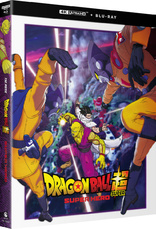
Movie rating
7.7 | / 10 |
Blu-ray rating
| Users | 0.0 | |
| Reviewer | 3.5 | |
| Overall | 3.5 |
Overview
Dragon Ball Super: Super Hero 4K (2022)
Descendants of the Red Ribbon Army's sinister leaders have renewed their quest for world domination. As their two ultra-powerful androids seek their own brand of justice against Earth's heroes, Piccolo and Gohan, must push their powers to new limits!
Starring: Masako Nozawa, Toshio Furukawa, Aya Hisakawa, Ryō Horikawa, Takeshi Kusao| Anime | Uncertain |
| Action | Uncertain |
| Foreign | Uncertain |
| Fantasy | Uncertain |
| Martial arts | Uncertain |
Specifications
Video
Video codec: HEVC / H.265
Video resolution: 4K (2160p)
Aspect ratio: 1.78:1
Original aspect ratio: 1.85:1
Audio
Japanese: Dolby Atmos
Japanese: Dolby TrueHD 7.1 (48kHz, 24-bit)
English: Dolby TrueHD 5.1 (48kHz, 16-bit)
Japanese: Dolby TrueHD 5.1
Japanese: Dolby TrueHD 5.1 (48kHz, 16-bit)
Subtitles
English
Discs
Blu-ray Disc
Two-disc set (2 BDs)
4K Ultra HD
Packaging
Slipcover in original pressing
Playback
Region A, B (locked)
Review
Rating summary
| Movie | 3.0 | |
| Video | 4.0 | |
| Audio | 4.5 | |
| Extras | 1.0 | |
| Overall | 3.5 |
Dragon Ball Super: Super Hero 4K Blu-ray Movie Review
Reviewed by Neil Lumbard November 13, 2023Dragon Ball Super: Super Hero brings back the fan favorite characters who make up the world of Dragon Ball. The feature-film grossed close to 100 million at the box-office worldwide and was a massive hit. A callback to the original series while paving the way forward, Dragon Ball Super: Super Hero once again brings back original manga creator Akira Toriyama for the production. Toriyama worked on the script and original character designs.
As created by Toriyama, Dragon Ball Super: Super Hero features CGI animation produced by Toei Animation (Dragon Ball, Dragon Ball Z). Produced by Norihiro Hayashida (Dragon Ball Super: Broly, Toward the Terra) and Rioko Tominaga (Dragon Ball Z: Battle of Gods, Dragon Ball Z: Resurrection 'F'), Dragon Ball Super: Super Hero has a nice blend of new and old ingredients for a fun ride for series fans. Long time fans and newcomers alike will want to take a look at the new feature-film.
Dragon Ball Super: Super Hero brings back the Red Ribbon Army as the central opposition for the cast of heroes. Magenta (Volcano Ōta) leads the way forward with the Red Ribbon Army. Determined to shape up the army, Magenta recruits the mad scientist Dr. Hedo. As the tale unfolds, the scope of the threat builds: the arrival of Cell Max (Norio Wakamoto) causes chaos and destruction.
As the world’s strongest heroes suit up once more to fight Cell, the latest version of Cell is the deadliest and most super-charged threat for the heroes to date. Gohan and Piccolo lead the way for the defense. Bulma, Trunks, Krillin, and other heroes join forces in order to help fight Cell Max and save the world from destruction. Can Cell Max be defeated?
The new installment focuses more on Gohan and Piccolo and their journeys as super heroes. These fan favorite characters take the reign. Though there are appearances by both Goku and Vegeta, fans will certainly want to keep some expectations in check. Goku and Vegeta are not the lead characters in Dragon Ball Super: Super Hero and this installment gives more screen time to the supporting cast.
Exploring the strengths of Gohan and Piccolo in new ways, Dragon Ball Super: Super Hero brings finds new ways to explore these action heroes. Both of these characters encounter new transformations in the new feature-film: Gohan transforms into Gohan Beast and Piccolo transformed into Orange Piccolo. These transformations amp up their power and help them to be better fighters when going up against the threat of Cell Max.
It is always nice to spend more time with the cast of characters in the Dragon Ball Z universe. This was one of the best elements of Dragon Ball Super and it is nice to see the franchise continue with new stories. Anyone who is a longtime fan of the series will appreciate seeing some nice callbacks. The characters are fun and one of the strengths of the saga. Gohan and Piccolo have always been some personal favorites of mine and it is nice to see Dragon Ball Super: Super Hero give them a bigger chance in the spotlight.
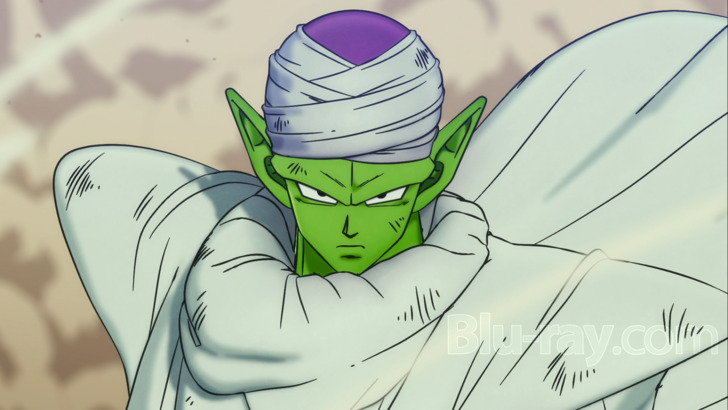
The action scenes are thrilling and intense. This is one of the best elements of Dragon Ball Super: Super Hero. Featuring adrenaline-pumping action sequences, Dragon Ball Super: Super Hero provides some thrilling escapist entertainment for franchise devotees. There is a lot of action-packed mayhem for audiences to enjoy. The battles are epic and the fights are over-the-top in the best way.
Unfortunately, Dragon Ball Super: Super Hero isn’t perfect. The feature-film is the first Dragon Ball anime feature to heavily use CGI as a main part of the production. Under the art direction of Nobuhito Sue (El-Hazard: The Magnificent World, Super Cub) and featuring animation direction by Chikashi Kubota (The Girl Who Leapt Through Time, One Punch Man), Dragon Ball Super: Super Hero looks artificial with many scenes. The animation simply doesn’t cut it during the character sequences and some of these moments look choppy and ill-conceived – like a prototype version of something that could be better. Disappointing.
The CGI direction by Jae Hoon Jung is one of the biggest issues. As the first major Dragon Ball Super film with extensive CGI, the animation could have used more focus and natural line art. The animation looks too artificial at times and it draws one out of the picture during the non-action scenes. These scenes are cheap looking and would have been better with simple hand-drawn animation or simply by sticking to the style of the previous Dragon Ball Super series. Though Dragon Ball Super: Super Hero tries to walk between CGI and traditional by attempting to resemble what came before, the sometimes jerky and choppy looking animation (especially in regards to facial features and the like) seems less authentic.
The score composed by Naoki Satō (Eureka Seven, Sword of the Stranger) is one of the more effective and pleasing aspects of Dragon Ball Super: Super Hero. The music is enjoyable and energetic. This is a rousing score with plenty of action- packed mayhem built in to the compositions. The score provides an excellent backdrop to the fight scenes and makes the filmmaking work better than it would with a less effective score.
The screenplay by Akira Toriyama (Dragon Ball Z: Resurrection 'F', Dragon Ball Super: Broly) is one of the strengths and best takeaways of the production. Of course, Toriyama has a solid understanding of these characters to crank out something entertaining and fun for the core fanbase – even if Dragon Ball Super: Super Hero never quite reaches the heights of the saga at its best. Toriyama is a good storyteller and this is where the film excels. It is simply nice to be back with these characters again.
Directed by Tetsuro Kodama (Eiga Kuma no Gakkō: Patissier Jackie to Ohisama no Sweets, Yūki no Hana ga Hiraku Toki: Yanase Takashi to Anpanman no Monogatari), Dragon Ball Super: Super Hero isn’t a perfect installment and much of this can be contributed to the director at the helm. The director is responsible for the overall aesthetic of the production. Koda chose to work with CGI for the film animation and it was largely their choice to work in the medium for the new Dragon Ball Super production.
CGI can be good in the right hands but this was a misstep in my estimation. The animation often felt too choppy and it made the work seem like a Betamax version waiting to roll out updates in the future. The action scenes are good and the spectacle is sometimes enjoyable but if there is a fault it is director Kodama not mastering the craft of CGI implementation – or simply sticking to what works. As the saying sometimes goes: if it isn’t broke, don’t fix it.
Dragon Ball Super: Super Hero 4K Blu-ray Movie, Video Quality 
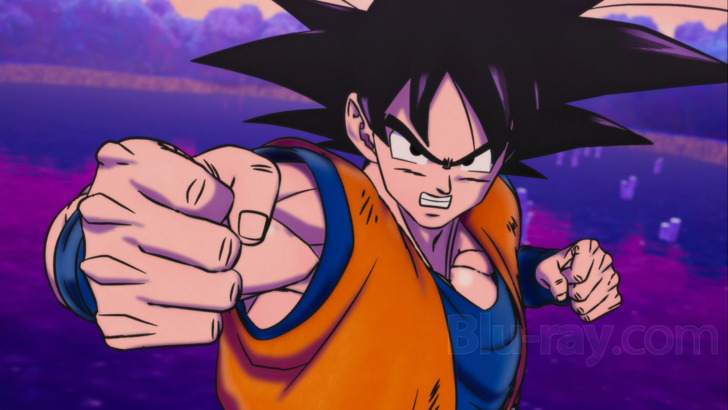
Released on 4K UHD by Crunchyroll, Dragon Ball Super: Super Hero is presented in 2160p HEVC / H.265 in an aspect ratio of 1.78:1 widescreen. The 4K UHD presentation is a obvious and engaging visual upgrade over the previously released Blu-ray edition of the feature-film. The 4K UHD provides a superior image with fewer issues with banding (this was perhaps the biggest upgrade in comparing the 4K to the standard Blu-ray) and a slightly more robust color scheme. The colors are certainly deeper and slightly more rewarding compared to the standard Blu-ray edition. This is no doubt due to the enhanced HDR (high dynamic range) presentation as it brings out the deepest blacks and brightest whites of the image, enhancing the color spectrum and allowing for a richer color scheme reproduction. The result? A subtle but highly effective upgrade over the previous Blu-ray edition. The presentation is upscaled 4K (not native) and as such the transfer doesn't gain anything of true value in regards to resolution – the transfer isn't sharper or clearer looking than the previous edition in any meaningful way – but the slightly bolder and deeper colors alongside less banding on the encode provides a more enjoyable viewing experience.
There are many scenes during the presentation that seemed only subtly improved to the point that I questioned how many viewers would have find the upgrade enticing enough – then the big action battles began to unfold in the later part of the feature presentation – as beams of color and deep stylistic flourishes of the cinematography unfolded, the 4K presentation started to truly shine and prove why it's a notable enough upgrade over the standard Blu-ray presentation. Videophiles looking for the absolute best presentation quality possible with superior color and less banding artifacts, will find the presentation a worthwhile upgrade. The transfer isn't night and day superior (this is, after all, only an upscaled to 4K presentation) so keep expectations in check if expecting a revelation – on the whole, the 4K seems to be a worthy upgrade and well worth one's time. The presentation was more enjoyable on the 4K UHD disc than it was on the standard Blu-ray release.
Dragon Ball Super: Super Hero 4K Blu-ray Movie, Audio Quality 
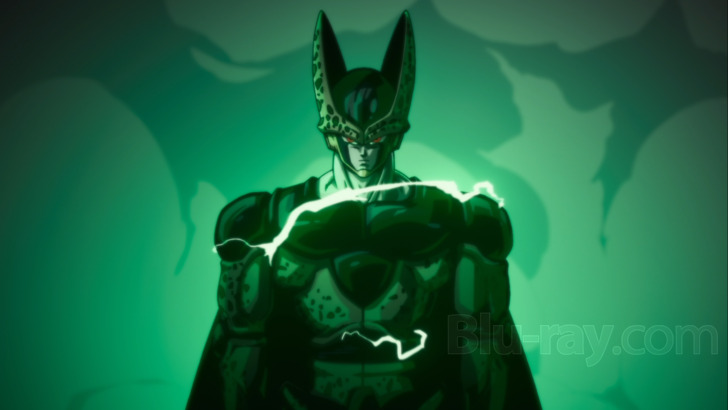
The release includes a Dolby Atmos audio presentation. The Japanese Dolby Atmos audio track adds spatial sound that was not included on the previous Blu-ray edition. The release also retains legacy Japanese Dolby TrueHD 7.1 (core audio for the Atmos) and English Dolby TrueHD 5.1 surround as provided on the previous Blu-ray edition. The good news is that the Dolby Atmos audio on the Japanese language version retains the same core characteristics of the Dolby encoding from the standard Blu-ray release while adding a little bit of extra subtlety and atmospheric sound-staging to the audio presentation.
The Atmos audio is somewhat reserved sounding compared to some of the more engaging and robust Atmos audio tracks I have heard included on other releases (particularly of major Hollywood films outside of the anime/animation realm) but it does have some added depth with the atmospheric audio element taking more effect during the final battle sequences in the feature-film. Some scenes certainly sound reserved and barely benefit from the Atmos mix while other scenes have a little bit more punch and the dynamics make the track slightly more engaging than what came before with the standard lossless Dolby TrueHD track. While the Atmos mix on the release is more reserved than anticipated, it adds some nice immersion during a few scenes and is still a notable upgrade for anyone equipped for Atmos playback.
Dragon Ball Super: Super Hero 4K Blu-ray Movie, Special Features and Extras 
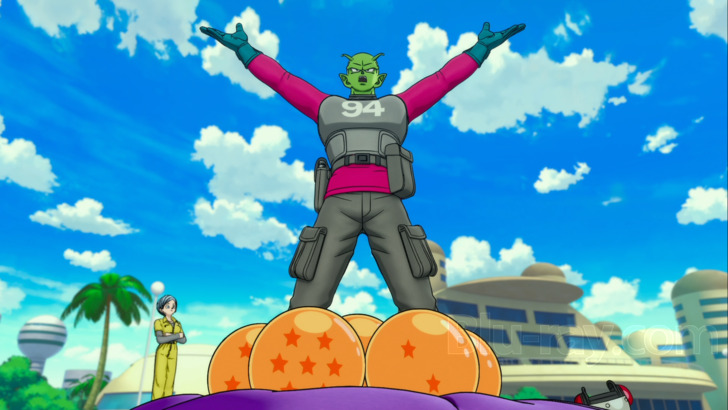
The 4K UHD release has a somewhat sparse and underwhelming supplemental package. In fact, the included 4K UHD disc only presents the 4K presentation of the feature-film while the standard Blu-ray disc in the package retains the same supplements as before. A more feature-packed release could have added some significant value to the package with new behind-the-scenes featurettes, cast and crew interviews, and the like. Unfortunately, the release is simply a port of what came before.
The only (arguably) new supplement is a new lenticular slipcover o-card sleeve alongside a shiny character artwork card included inside of the package. Admittedly, the lenticular slipcover has a nice design, showcasing the key artwork with the characters engaged in battle poses and the bonus art card adds some considerable flair to the package, too. The release is also made available co-currently alongside exclusive 4K steelbook editions (sold separately).
On disc supplements:
Promo Videos (HD, 5:27)
Trailers (HD, 4:31)
Dragon Ball Super: Super Hero 4K Blu-ray Movie, Overall Score and Recommendation 
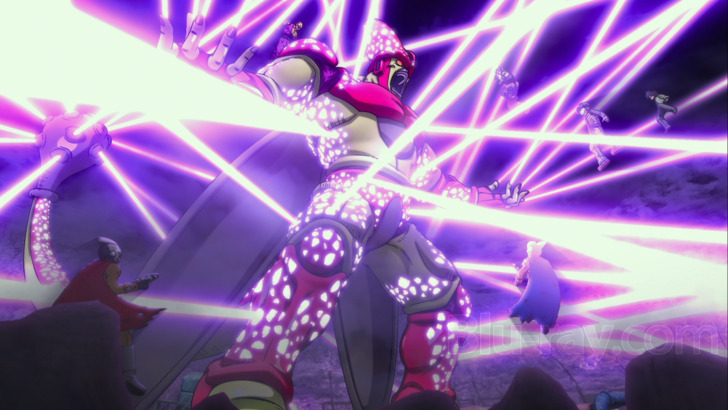
Dragon Ball Super: Super Hero returns to the home media arena with a new 4K UHD presentation. The feature-film benefits from a superior 4K presentation with upscaled-to-4K 2160p alongside new high dynamic range (HDR) encoding. The transfer has superior color reproduction with deeper colors – showcasing the animation at its absolute best. The Dolby Atmos audio adds a subtle and appreciable upgrade (only for the Japanese language version). The release isn't night-and-day superior to the former release, which already offered excellent video and audio, but it does offer a slight upgrade in quality and for true videophiles seeking the best possible presentation, the release is worth consideration. The set also comes with a nice collectible lenticular slipcover and an art card. Recommended.
Other editions
Dragon Ball Super The Movie 2: Super Hero: Other Editions

Dragon Ball Super: Super Hero
2022

Dragon Ball Super: Super Hero 4K
2022

Dragon Ball Super: Super Hero 4K
2022
Similar titles
Similar titles you might also like

Dragon Ball Super: Broly
2018

Dragon Ball Z: Resurrection 'F'
2015

Dragon Ball Z The Movie 8: Broly - The Legendary Super Saiyan
1993

Dragon Ball Z The Movie 7: Super Android 13
1992

Dragon Ball Z The Movie 9: Bojack Unbound
1993

Dragon Ball Super: Complete Series
Limited Edition
2015-2018

Dragon Ball Z: Battle of Gods
Extended Edition
2013

Dragon Ball GT
1996-1997

Dragon Ball Z The Movie 13: Wrath of the Dragon
1995

Dragon Ball Z The Movie 10: Broly - Second Coming
1994

Dragon Ball Z: The History of Trunks
1993

Dragon Ball Z: Bardock - The Father of Goku
1990

Dragon Ball Z The Movie 12: Fusion Reborn
1995

Dragon Ball Z The Movie 11: Bio-Broly
1994

Dragon Ball Z The Movie 2: The World's Strongest
1990

Dragon Ball Z The Movie 6: The Return of Cooler
1992

Dragon Ball Z The Movie 5: Cooler's Revenge
1991

Dragon Ball Z The Movie 4: Lord Slug
1991

Dragon Ball Z Kai: Season 1
2009

Dragon Ball Z The Movie 1: Dead Zone
1989